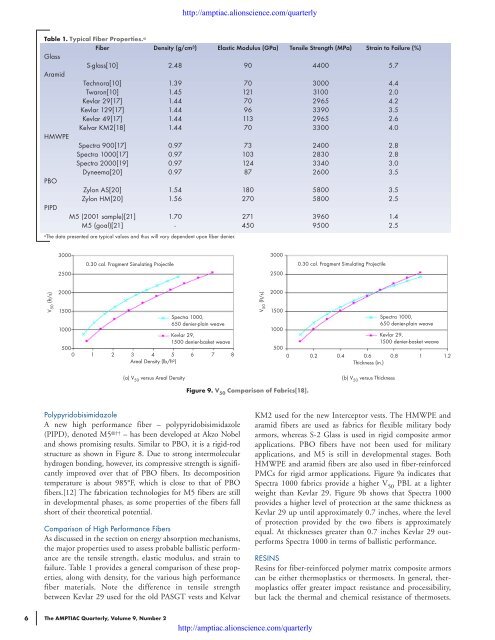AMPTIAC Quarterly, Vol. 9, No. 2, Summer/Fall 2005 - Advanced ...
AMPTIAC Quarterly, Vol. 9, No. 2, Summer/Fall 2005 - Advanced ...
AMPTIAC Quarterly, Vol. 9, No. 2, Summer/Fall 2005 - Advanced ...
Create successful ePaper yourself
Turn your PDF publications into a flip-book with our unique Google optimized e-Paper software.
Table 1. Typical Fiber Properties. a<br />
Glass<br />
Aramid<br />
HMWPE<br />
PBO<br />
PIPD<br />
Fiber Density (g/cm 3 ) Elastic Modulus (GPa) Tensile Strength (MPa) Strain to Failure (%)<br />
S-glass[10] 2.48 90 4400 5.7<br />
Technora[10] 1.39 70 3000 4.4<br />
Twaron[10] 1.45 121 3100 2.0<br />
Kevlar 29[17] 1.44 70 2965 4.2<br />
Kevlar 129[17] 1.44 96 3390 3.5<br />
Kevlar 49[17] 1.44 113 2965 2.6<br />
Kelvar KM2[18] 1.44 70 3300 4.0<br />
Spectra 900[17] 0.97 73 2400 2.8<br />
Spectra 1000[17] 0.97 103 2830 2.8<br />
Spectra 2000[19] 0.97 124 3340 3.0<br />
Dyneema[20] 0.97 87 2600 3.5<br />
Zylon AS[20] 1.54 180 5800 3.5<br />
Zylon HM[20] 1.56 270 5800 2.5<br />
M5 (2001 sample)[21] 1.70 271 3960 1.4<br />
M5 (goal)[21] - 450 9500 2.5<br />
aThe data presented are typical values and thus will vary dependent upon fiber denier.<br />
3000<br />
2500<br />
0.30 cal. Fragment Simulating Projectile<br />
3000<br />
2500<br />
0.30 cal. Fragment Simulating Projectile<br />
V 50 (ft/s)<br />
2000<br />
1500<br />
1000<br />
Spectra 1000,<br />
650 denier-plain weave<br />
Kevlar 29,<br />
1500 denier-basket weave<br />
500<br />
0 1 2 3 4 5 6 7 8<br />
Areal Density (lb/ft 2 )<br />
V 50 (ft/s)<br />
2000<br />
1500<br />
1000<br />
500<br />
Spectra 1000,<br />
650 denier-plain weave<br />
Kevlar 29,<br />
1500 denier-basket weave<br />
0 0.2 0.4 0.6 0.8 1 1.2<br />
Thickness (in.)<br />
(a) V 50 versus Areal Density<br />
(b) V 50 versus Thickness<br />
Figure 9. V 50 Comparison of Fabrics[18].<br />
Polypyridobisimidazole<br />
A new high performance fiber – polypyridobisimidazole<br />
(PIPD), denoted M5 ®†† – has been developed at Akzo <strong>No</strong>bel<br />
and shows promising results. Similar to PBO, it is a rigid-rod<br />
structure as shown in Figure 8. Due to strong intermolecular<br />
hydrogen bonding, however, its compressive strength is significantly<br />
improved over that of PBO fibers. Its decomposition<br />
temperature is about 985°F, which is close to that of PBO<br />
fibers.[12] The fabrication technologies for M5 fibers are still<br />
in developmental phases, as some properties of the fibers fall<br />
short of their theoretical potential.<br />
Comparison of High Performance Fibers<br />
As discussed in the section on energy absorption mechanisms,<br />
the major properties used to assess probable ballistic performance<br />
are the tensile strength, elastic modulus, and strain to<br />
failure. Table 1 provides a general comparison of these properties,<br />
along with density, for the various high performance<br />
fiber materials. <strong>No</strong>te the difference in tensile strength<br />
between Kevlar 29 used for the old PASGT vests and Kelvar<br />
KM2 used for the new Interceptor vests. The HMWPE and<br />
aramid fibers are used as fabrics for flexible military body<br />
armors, whereas S-2 Glass is used in rigid composite armor<br />
applications. PBO fibers have not been used for military<br />
applications, and M5 is still in developmental stages. Both<br />
HMWPE and aramid fibers are also used in fiber-reinforced<br />
PMCs for rigid armor applications. Figure 9a indicates that<br />
Spectra 1000 fabrics provide a higher V 50<br />
PBL at a lighter<br />
weight than Kevlar 29. Figure 9b shows that Spectra 1000<br />
provides a higher level of protection at the same thickness as<br />
Kevlar 29 up until approximately 0.7 inches, where the level<br />
of protection provided by the two fibers is approximately<br />
equal. At thicknesses greater than 0.7 inches Kevlar 29 outperforms<br />
Spectra 1000 in terms of ballistic performance.<br />
RESINS<br />
Resins for fiber-reinforced polymer matrix composite armors<br />
can be either thermoplastics or thermosets. In general, thermoplastics<br />
offer greater impact resistance and processibility,<br />
but lack the thermal and chemical resistance of thermosets.<br />
6<br />
The <strong>AMPTIAC</strong> <strong>Quarterly</strong>, <strong>Vol</strong>ume 9, Number 2

















